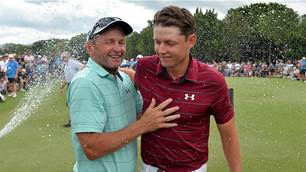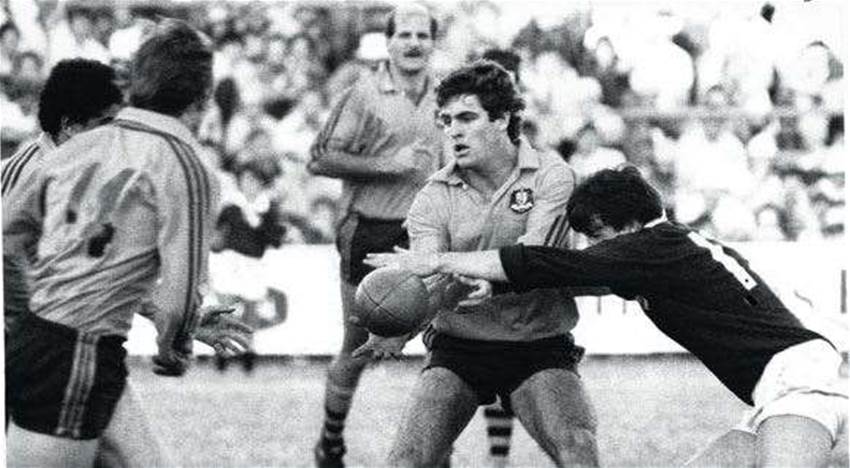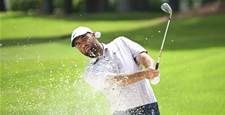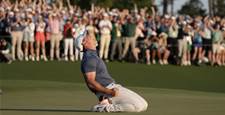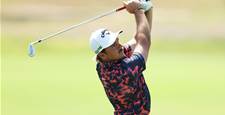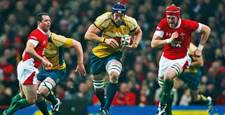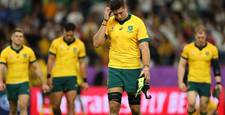If there’s one thing international rugby union and rugby league have in common these days, it’s that they bear absolutely no resemblance to the forms they took back in Michael O’Connor’s playing days
If there’s one thing international rugby union and rugby league have in common these days, it’s that they bear absolutely no resemblance to the forms they took back in Michael O’Connor’s playing days.
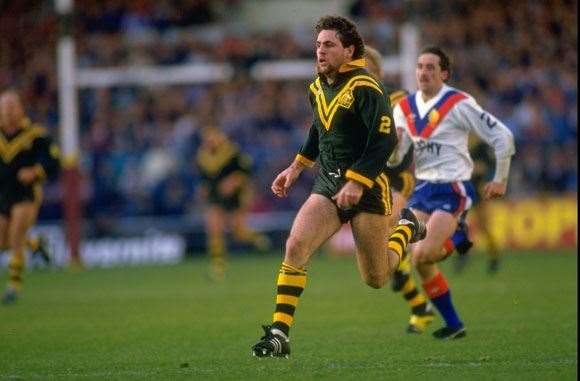 Chasing the action for the Kangaroos in ‘86.
Chasing the action for the Kangaroos in ‘86.Image: Getty Images
Gone are the lengthy ’Roo tours and Wallaby grand slam tour pre-Test clashes, when goalkicking and tryscoring freaks like “Snoz” could roam the old country piling on 170 points through 13 tries and 59 goals, like he did in the Kangaroos’ visit there in ’86. Just 23 days will separate the ’Roos first and last games in the inaugural Four-Nations tournament this month, while the Wallabies will wrap their Spring Tour up 29 days after their opening Test against the All Blacks in Tokyo. Few men cover the rugby codes spectrum as well as current national rugby sevens coach O’Connor. He’s a busy man. He shared his thoughts on Australia’s chances of union and league success in Blighty in ’09 with Inside Sport while at Sydney airport during a single-day stop in the harbour city (he’d flown in from Perth that morning) before jetting to join the lads in camp at Canberra.
Your young charges start their campaign in the latest IRB Sevens World Series on December 4-5 in Dubai … Did you ever think you’d one day be mentoring the national sevens squad?
“Not really, not until Robbie Deans was appointed to coach the 15s, anyway. I’d always had an underlying feeling that we could be doing more with sevens, using it as an effective way of developing and fast-tracking players into Super 14 and Wallaby teams. When Robbie was appointed, for the first time in a number of years we had a coach who had seen what sevens can do. New Zealand’s system has produced a number of All Blacks. They’ve been world sevens champs I think on about eight occasions. Robbie was very important to the whole concept of Australia seriously concentrating on sevens, the fact he felt it’s a good thing for the 15s game.
 Mike O'Connor. Image: News Pix
Mike O'Connor. Image: News Pix“There’s always been a belief in Australian rugby that sevens is a different animal altogether and therefore not suitable for 15s preparation. Whereas Robbie’s opinion is different, as is mine. I think sevens is a wonderful avenue – from a talent ID perspective, that’s my background – to develop opportunities for young players coming out of under-20s and colts who would otherwise just be playing suburban football.”
The current Wallaby line-up proves different “animals” can work together to nurture talent, yes?
“Drew Mitchell’s played sevens, Peter Hynes has played sevens – he was a very good sevens player. James O’Connor, Matt Giteau, Adam Ashley-Cooper. They were all sevens players.”
Considering how fast and furious the action can get, what on Earth do you tell your players before they hit the turf for a sevens game?
“I think the most important things for players to have are athleticism, fitness, and the ability to be across all the major disciplines of the game. You can’t be deficient in one area. It’s a little bit like basketball – you only need one person to let you down. Everybody has to be on-song: they have to be fit, they have to be effective at the tackle and at the breakdown. You have to have that desire to get off the ground and work hard.”
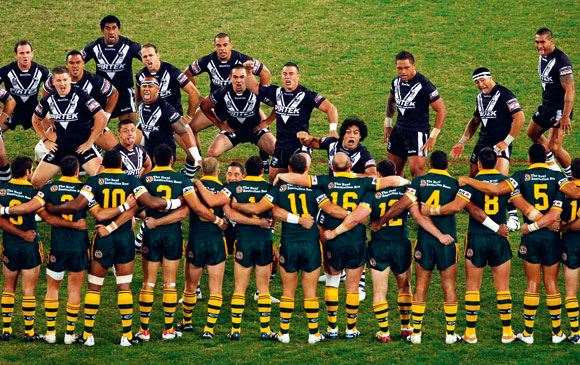 Modern international league combat. Images: Getty Image
Modern international league combat. Images: Getty ImageThe South Africans took the sevens world title last season … How close to touching the trophy are the Aussie boys?
“Last year was a learning experience. We had a young squad. Just two of our players had played sevens before, the rest hadn’t – sevens isn’t big over here. They learnt a hell of a lot as a young squad, learnt from their mistakes, and they’ll be better for it. I’m hoping to keep the nucleus of that squad, introduce some more new and young players this year, and I’m quite optimistic that we can move up the world rankings.”
You developed a great eye for spotting young stars and have been described as “working for the enemy” – no matter what code you’ve been with – at times. How did the whole talent ID/recruitment profession come about for you?
“I sort of fell into it. I was working for News Limited, for the Super League, and I was across players, what they were worth, contract negotiations. I went down to the Adelaide Rams, had a year down there, ended up as their CEO. I had a year in Brisbane, in more of a marketing role there. I had a chance meeting with Jeff Miller, who was the high-performance manager for the ARU back in about 2000/01. At the time, rugby union was looking to bring some high-profile rugby league players across. I’d been approached by Wendell Sailor about the possibility of changing codes. I was involved in his decision to come over, and Matt Rogers’. There was a policy to try and get the best union players and rugby league players.”
So the meetings held in secret, with blinds closed, heads of union and league planning raids on the rival code, do they really happen?
“Back then it was all about just getting the best players. They didn’t have to be rugby union players. It was an experimental thing. From that spawned my job of really studying up-and-coming union talent and also looking at young rugby league players, whether they’d be suitable to play rugby union. The fact is a lot of young players play both union and league at school. I started doing that for the Australian Rugby Union part-time, going to carnivals etc.
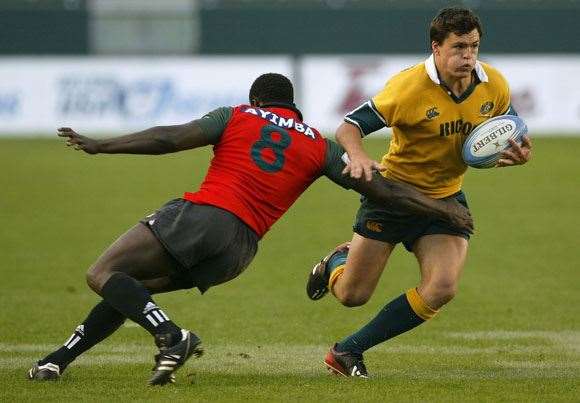 Adam Ashley-Cooper, a fine sevens exponent. Images: Getty Images
Adam Ashley-Cooper, a fine sevens exponent. Images: Getty Images“I got involved with the sevens because they needed a manager to go away with the team. It’s a tight budget, a small group; you have a physio, manager and a coach. They needed a manager to go over to South America the year I started, so I went over there to Argentina and Chile. Peter Hynes and Matt Giteau were in that side. “I’d played three years of sevens myself in Hong Kong in the early ‘80s. I was quite a fan. So I’ve always thought sevens is a good game, great development tool, underutilised and something that potentially can be very powerful for the code, seeing as though it’s been ‘given the tick’ for the Olympics in 2016.”
We’ve had an ordinary season against the ‘Boks and All Blacks. Is it going to be a bit easier in Britain, with their teams down the bottom end of the current world rankings?
“Never. There’s no such thing. We’ll take a best-possible-squad over there. For them, it’s all about home games and home conditions, playing at their headquarters at Twickenham, Murrayfield, Croke Park and Millenium Stadium. They won’t be easy games. No way.”
You toured with the Ella brothers in ‘77 with the Aussie Schoolboys union side, and also with “The King”, Wally Lewis. What kind of kids were those blokes back then?
“I did play with them in the ‘77 Schoolboys, and then in ’81 I went on a British Isles tour with the Ella boys. Wally got injured a bit, but he was extraordinarily competitive and a very very tough opponent. And Mark Ella, I’d say he was the most gifted five-eighth I played outside of, as far as getting early quality ball and having options.”
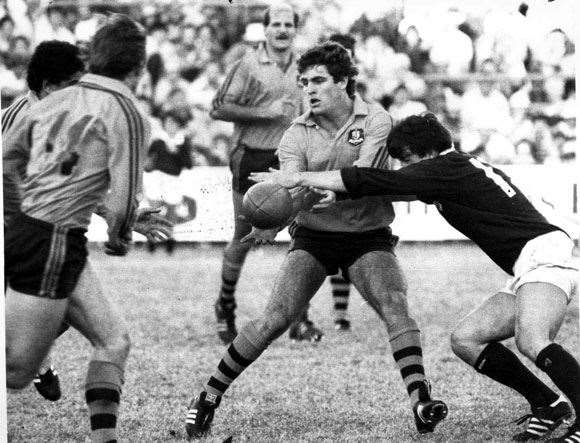 Offloading for the Wallabies in ‘82. Images: Getty Images
Offloading for the Wallabies in ‘82. Images: Getty ImagesWhat kind of player were you back then? Did your style change much with experience?
“I’ve always been about running the ball. I guess that’s why I went well in league, because I liked to carry the ball. In rugby, back
then, there wasn’t always the opportunity to do that, depending on the conditions, how much kicking there was in the game and the extra players on the field in rugby, too. I think the game of rugby has developed into a far better game than it was when I played it.”
Do you think back and shake your head at the fact you took the field with some of the greatest rugby union players of all time?
“Everyone’s mortal. Everyone’s human. I had a good career. I have very fond memories. I love the game. It’s great to reflect on past players, but they’re just human beings.”
What about the Kangaroos? First touring campaign for Tim Sheens. Are you expecting anything other than the Aussies dominating the Four-Nations?
“No. Particularly given that Tim Sheens is in charge. I’m often asked about coaches in rugby league and he’s right up there. I was fortunate enough in 1991 to have Tim Sheens as a coach. I was 31 and had played State Of Origin for a number of years, so I was probably entitled to think I knew everything, but I learnt a hell of a lot under Tim Sheens. I tell you, he’s a very good coach. You can see that in the teams he coaches, the style of football they play. I think it’s really refreshing. There’s one side I’ll watch – if I know the footy will be on TV when I’m near one – and it’s the Wests Tigers. Tim Sheens encourages good ball movement, good deception in the backs and players who aren’t afraid to have a go off a set piece. The Tigers under anyone but him might well get towelled-up.”
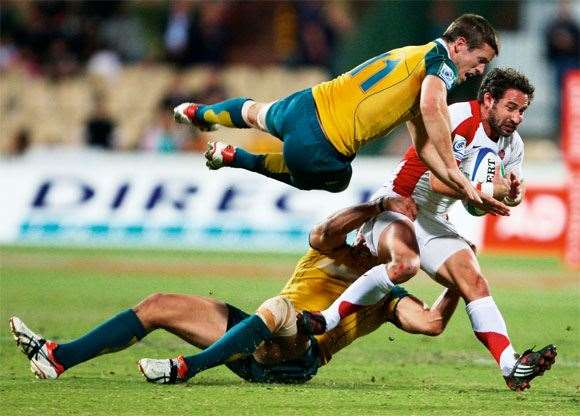 It ain’t the circus ... It’s sevens rugby. Images: Getty Images
It ain’t the circus ... It’s sevens rugby. Images: Getty ImagesSpeaking of ’91, that was the year you landed that winning sideline conversion in the pelting rain at the SFS to keep the Blues alive in the series. Any magic words you gave yourself before putting boot to ball?
“A lot of people don’t realise that the week before, we played the Maroons at Lang Park and were beaten. Basically we scored a try on the bell and I had a chance to kick a goal from the sideline to draw the game and I missed.
“What I did do as a goalkicker was practise a lot. That miss just inspired me. I was out kicking balls all week. So when I finally got that shot, I was confident. I couldn’t get the ball on the mound to kick it quickly enough and I knew as soon as I’d hit it, I’d hit the sweet spot. I needed to because it was a wet night. It wasn’t an easy one, but it wasn’t an accident or fluke, either.”
You played a feature roll for the “Unbeatables” on that gloriously successful Kangaroos Tour of 1986. Does it sadden you to know that long rep tours like that are lost to league and union?
“Both codes have been great to me from a travel point of view. I do understand the workload and the commitment players have to make now and I certainly understand why they’ve scheduled games the way they have. With all the games they play throughout the year, and then their end-of-season tours, it’s very demanding. I understand it. But I still feel very fortunate that I came through at a period of full three-month rugby union tours and two-and-a-half-month league Kangaroo tours.”
– James Smith
Related Articles
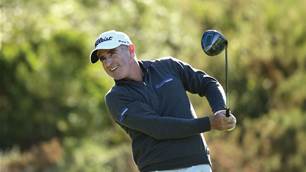
Video interview: Drinks With ... Matt Millar

Viva Las Vegas: Join Golf Australia magazine's Matt Cleary on a golf and rugby league spectacular
